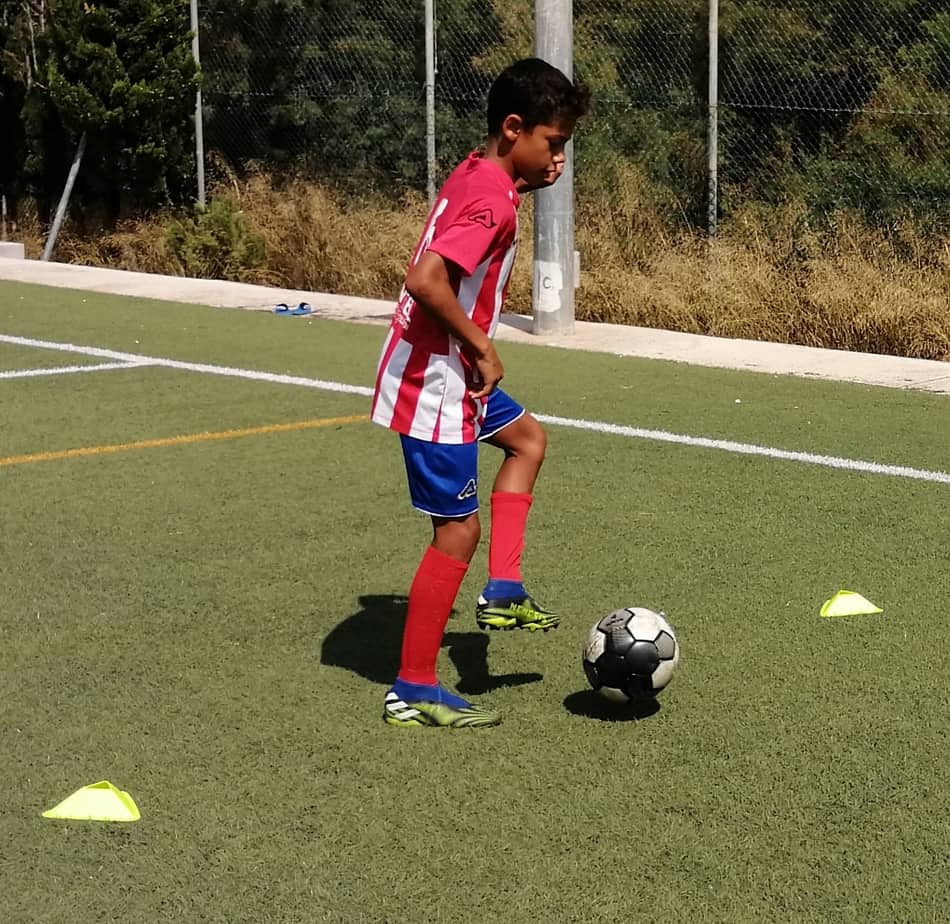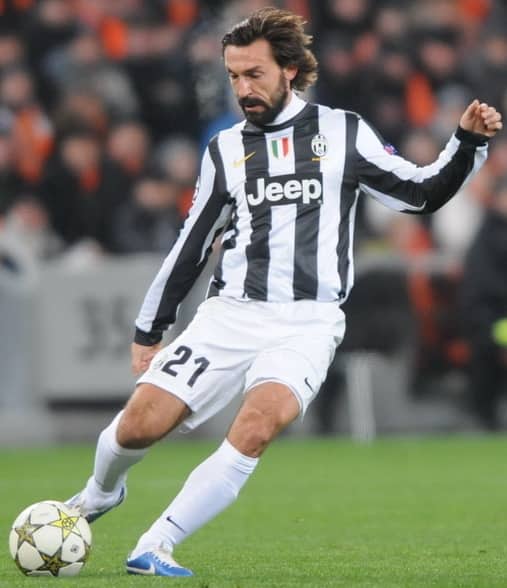Although players should be allowed to form their own way of doing things, even if unorthodox, it is important for coaches to step in when a player is not able to execute a skill successfully to teach the correct technique. I have put together a list of football skills with all the technical aspects that a coach needs to demonstrate to their players.
Here is the list of the football (soccer) techniques that should be coached to players regularly throughout a season:
- Control
- Dribbling
- Ball juggling
- Passing
- Ball protection
- Shooting
- Tackling
- Interception
- Heading
It is important to create a session plan that focuses on one or more of these skills in every training session. If you would like to know more about how to do this, then check out How to plan a soccer coaching session for beginners.
THE CONTROL

Types of control:
Without orientation
- Stop the ball dead
With orientation
- Semi-stopped
- Cushion
- Control on the move
- Control with more than one touch
Basic principles for good control:
- Offer security with the surface area used to control the ball
- Relax upon making contact with the ball
- Adjust yourself in respect to the ball and other players
Necessary qualities to perfect the control:
- Excellent balance
- Coordination of movements
- Total attention and vision of the ball
Areas of contact:
Foot:
- Interior/Inside
- exterior/Outside
- Frontal part of the instep
- Interior instep
- Exterior instep
- Heel
- Sole
- Toecap
Body:
- Leg
- Muscle
- Chest
Head:
- Forehead
- Parietal
Dribbling

Basic principles for good control:
- Caress the ball
- Good vision of where the ball is and the space
- Protection of the ball
Benefits of dribbling
- Maintain the initiative of play
- Progress the ball up the field
- Waste time
Negatives of dribbling
- Physically and mentally tiring
- Excessive dribbling can slow down play, find more obstacles and reduce the spaces
- Exposes a player to increased risk of injury
We have two types of dribbling which are close dribbling skills and speed dribbling.
Close dribbling – Is used in tight areas where the space is limited and so a player must keep the ball close to their feet whilst travelling with the ball.
Speed dribbling – Is used when a player finds themselves in an area where there is no opposition in close proximity which allows the player to push the ball forwards, at a greater distance than close dribbling, to be able to run with the ball at high speeds.
BALL JUGGLING SKILLS
Ball juggling skills consist of keeping the ball in the air whilst under the control of the player using various parts of their body to make contact with the ball.
Types of juggling skills:
Static – The player and ball stay in the same place (juggling on the spot)
Dynamic – The player and the ball are on the move (travelling with the ball)
Qualities needed for ball juggling
- Great ball control
- Great body control
- Physical speed in short movements
- Coordination
- Clarity of ideas for its execution
BALL PROTECTION
This is the technical action of protecting the ball from the opposition, with the player utilising their body.
Protection variations:
– Depending on the action: dynamic or static
– Depending on the protection: From the side or the back
Qualities needed:
- Strength
- Balance
- Composure
- Awareness
Basic principles for protecting the ball:
- Place the body between the ball and the opposition player
- Sideways on so that the ball is furthest away from the rival player as possible
Passing

Concept
A collective technical-tactical action that allows two or more members of a team to work in tandem, through the transmission of the ball, by utilising a pass.
When a player sends the ball to a teammate, either through a short, medium or long pass. This can be done using various parts of the foot.
| Type of Pass | Distance |
| Short | 0-15 |
| Medium | 16-30 |
| Long | 31+ |
Areas of contact:
1. Instep
- This offers great security in the pass with its large contact surface area
- Using this part of the foot is highly recommended for beginners
- Widely used for short (secure) passes and shots at goal that require precision.
2. Frontal instep
- Strike made with the internal part of the foot, specifically with the initial area of the first metatarsal
- It is the second type of striking a ball which is a more difficult technique than the first one (short pass with the instep)
3. Front part of the foot (the laces)
- To be taught to players who have had certain degree of practice and are already knowledgeable of the previous technique of striking the ball due to its complexity of execution
- Widely used for long distance passes, high speed shots and shots from distance. It is also generally used for long distance goal kicks
- Can also be used for volleys and overhead kicks
4. Frontal outstep (outside of the foot)
- Strike made with the outside of the foot and which corresponds to the area framed by the little toe and part of the external instep
- To be taught to players that have a decent level of competence with the previous types of striking the ball with more secure parts of the foot.
SHOOTING
It is the most important action of a football player and the last contact of the ball that ends a team’s attack on an opponents goal. To perform this technical action, any contact surface is valid if its execution does not break the laws
of the game. The most commonly used contact surfaces are the feet and the head.
When the shot is made there are a series of conditions to take into account,
depending on whether it is with respect to the player, the ball, opposition or any other aspects that will determine the shot’s effectiveness.

Considerations:
1. In respect to the player and according to his/her situation
- Standing waiting for the ball
- On the move when receiving the ball
- If it is carried out after an individual action
2. In respect to the ball according to:
- Position of the ball on the pitch
- Height: high, low and number of bounces (half volley)
- Trajectory: with or without effect on the ball such as ascending, descending, straight or curved
3. Other aspects to take into account for the player shooting:
- Is the goal area reduced?
- Positioning of the goalkeeper
- Positioning of opposition player
- The amount of opposition players close by
- Situation of teammates
- Shooting distance
- Shooting angle
Characteristics that a player should posses when shooting
| Technical | Psychological |
| – Full control of the ball – Striking power – Striking with precision – Maximum balance | – Decisive decision making – Perform with conviction – Being persistent |
Tackling
It is the defensive physical-technical action by means of which the player who
performs it, tries to snatch the ball from the opponent or prevents the opponent’s progress across the pitch.
Types of tackling:
From the front: It is done when the player in possession loses control of the ball for a moment.
Lateral: The tackle is made with the closest foot to the rival player.
From behind: The nearest leg is bent and the tackle is made with the foot furthest away from the opponent by sweeping the leg around (this tackle is getting more difficult to utilise with the modern changes to the rules on what is considered as a foul).
Interception
It is the defensive technical action by means of which a ball that has been sent by an opposing player, through a pass or throwing etc, is cut out and possession is gained.
Bases for a good sense of interception:
- Decision capacity
- Quick view of the ball and the opponent
- Pure and exclusive attention in the game
- Speed of movements
- Body strength, coordination, balance and agility
- Courage in taking action
- Conviction in getting to the ball first
Heading
Areas of contact:
Front forehead – Power and direction
Frontal parietal – Power and direction
Parietal – Deviations
Occipital – Flickons
Different ways to execute the header in relation to the position of the player:
- Still position
- Standing jump
- On the run (without jumping)
- Running jump
- Diving
The destination of each contact is also different, depending on the function that is being carried out, that is defensive or attacking.
Defensive: Interceptions (clearance)
Attacking: Passes, shots, flickons
Considerations regarding heading the ball are as follows:
Attacking Aspects
- Downward trajectory
- Depending on the speed of the ball: no power need / need to create power
- A pass (cushion header)
- A header at goal
Defensive Aspects
- Upward trajectory
- Simply to clear the ball from danger
- Looking for distance
Purpose of the header
Shots: Any delivery towards the opponents goal with the intention of scoring a goal.
Flick ons: When the ball does not change its trajectory but it’s height.
Clearance: Action of moving the ball away from our goal.
Along with knowing the technical components of each of the listed techniques, it is also good to know:
- Technique classification
- Training methods
- Planning
TECHNIQUE CLASSIFICATION
Individual technique – All the actions that are capable of developing a football player, dominating and playing the ball for the benefit of oneself.
Collective technique – They are the actions that manage to link two or more
players of the same team, always looking for the benefit of the whole.
Defensive technique – They are the actions that a player performs, which
starting from a defensive situation, intervenes directly with the intention
to seize the ball or, neutralizing the defensive evolutions of the
opposing team preventing the ball from reaching the proposed destination.
